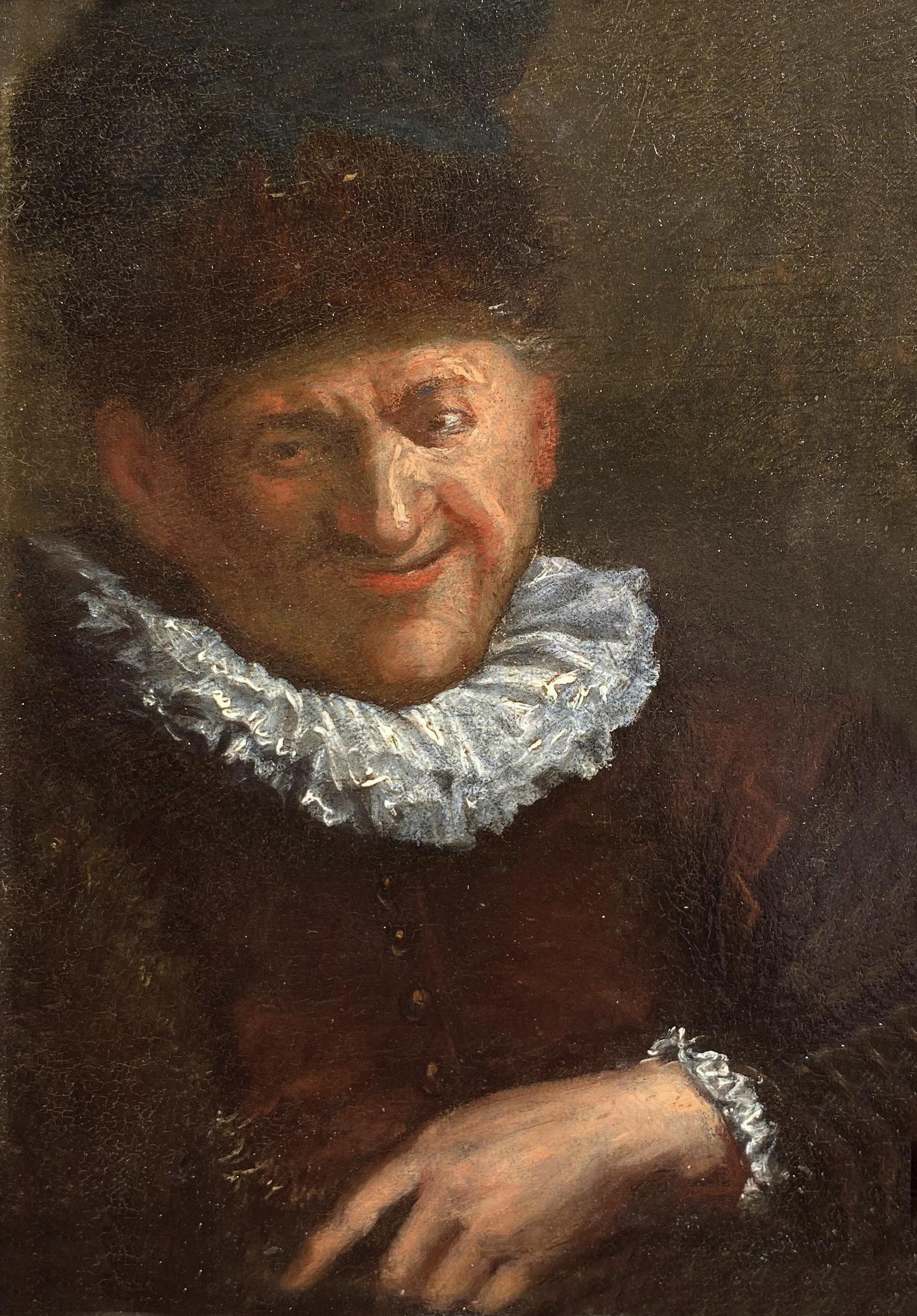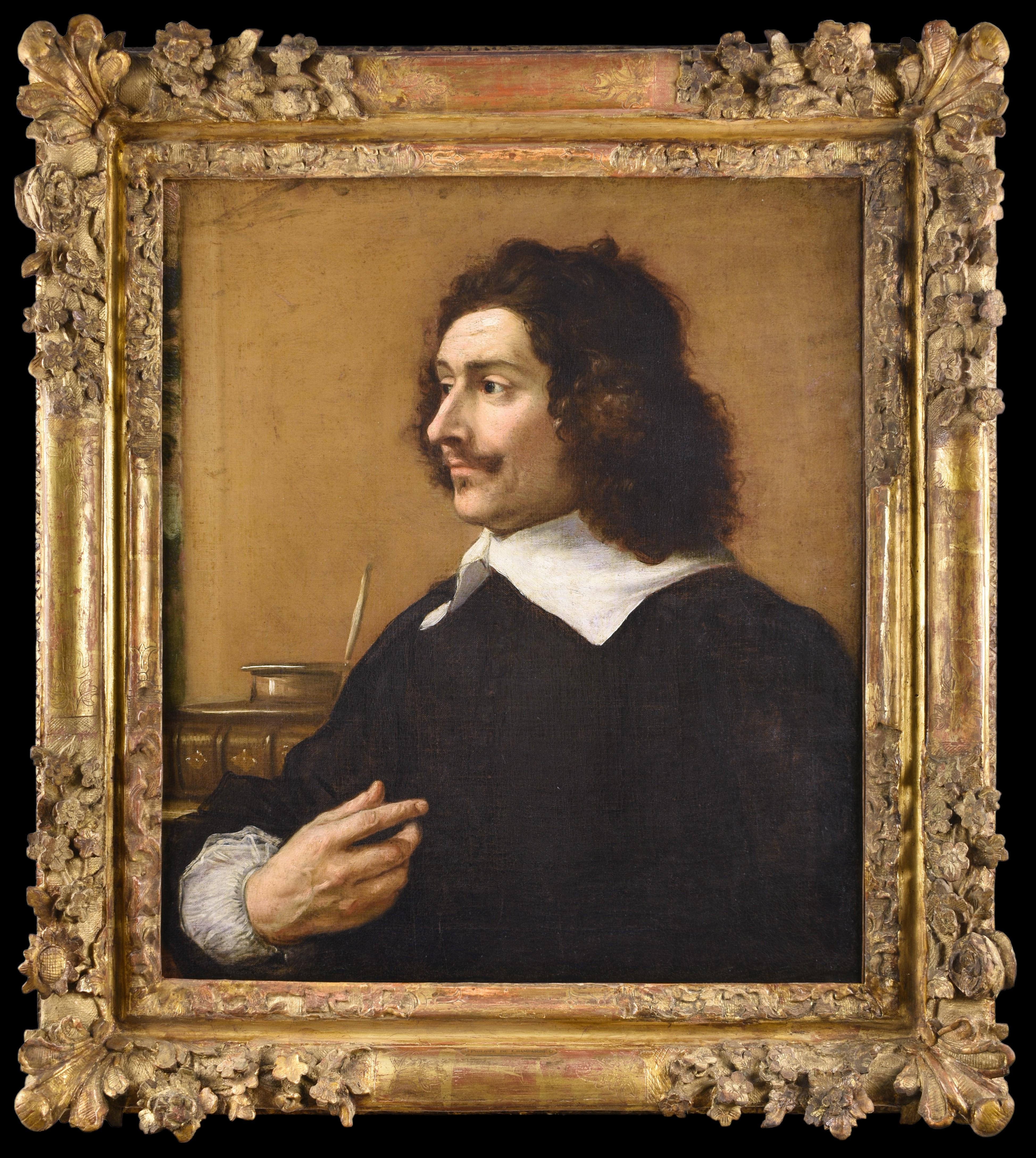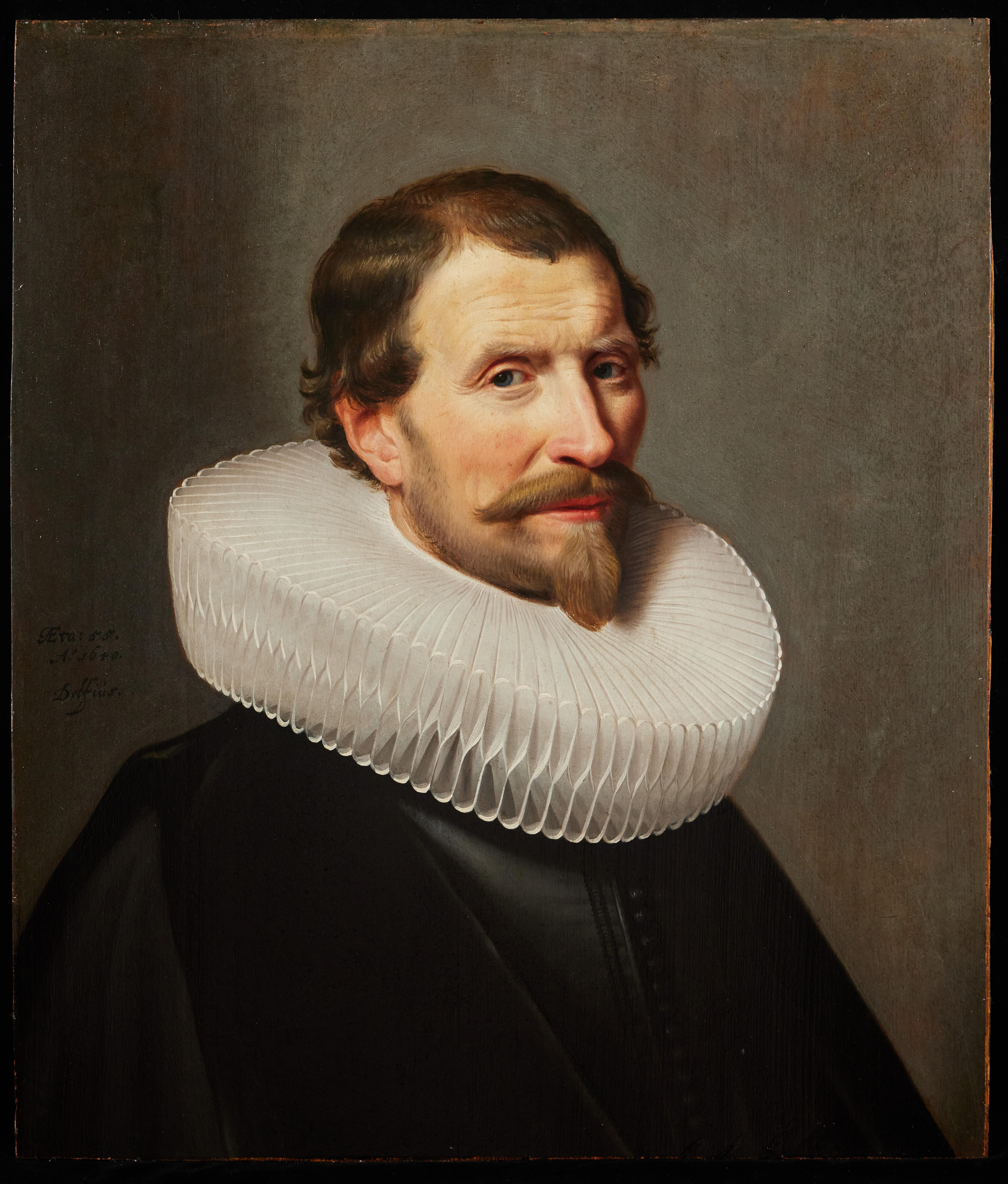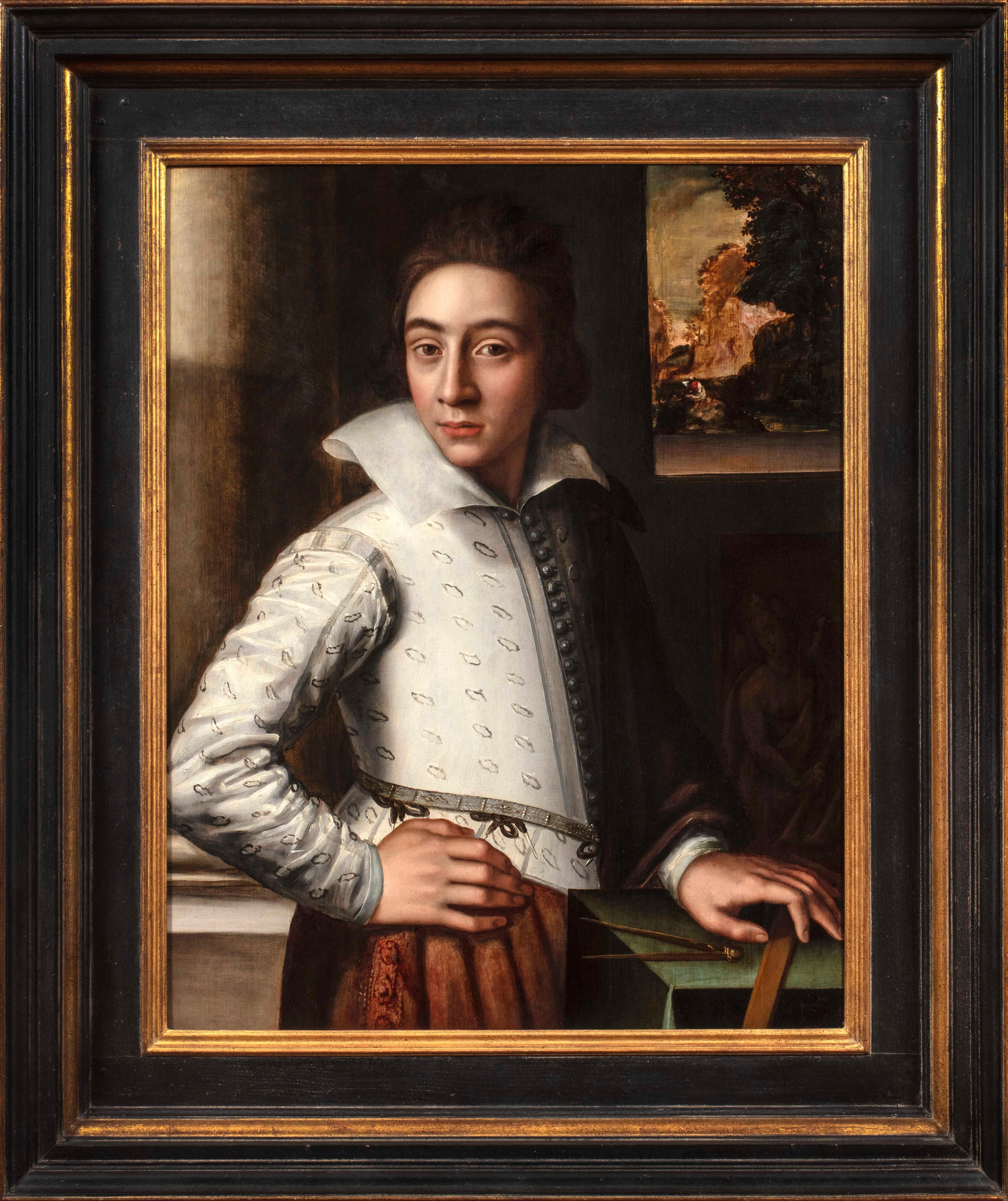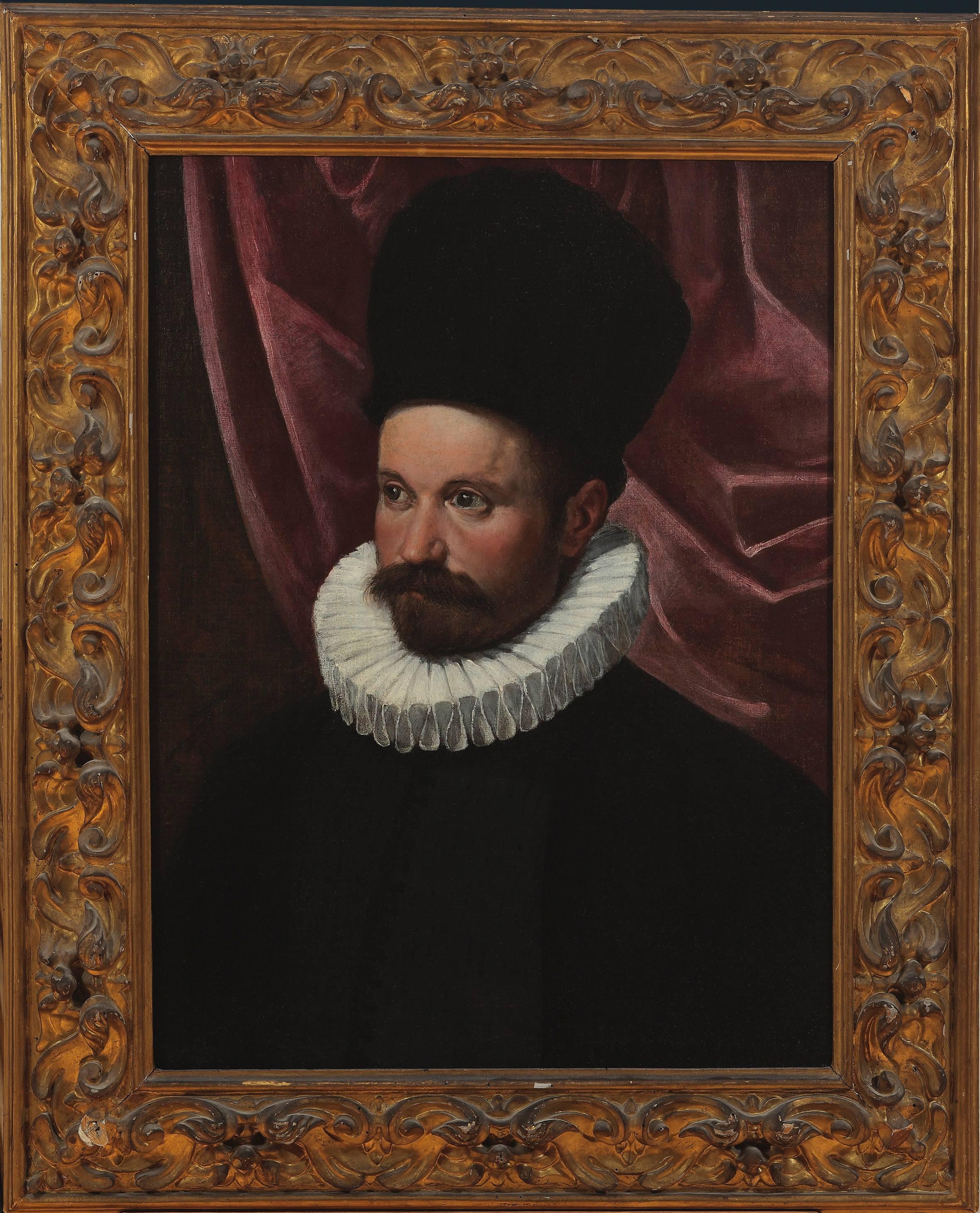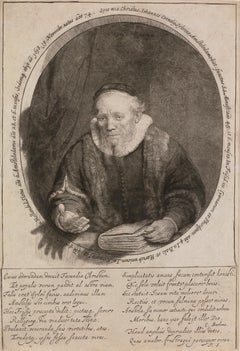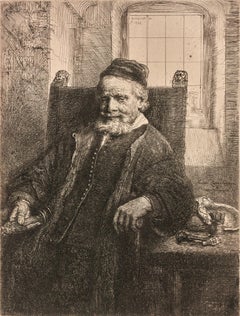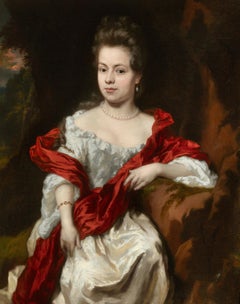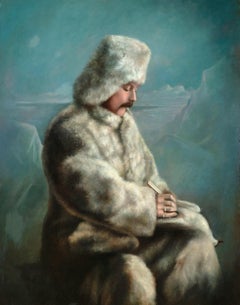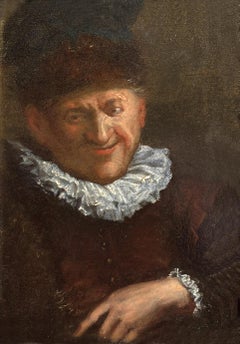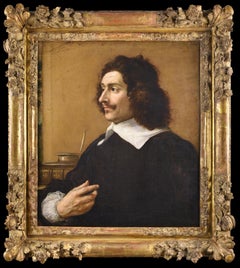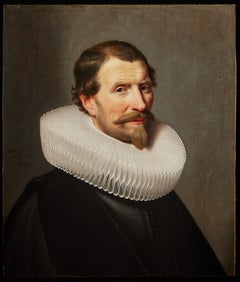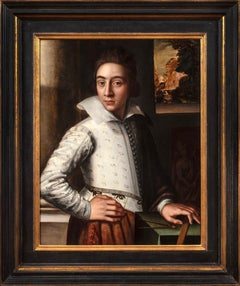Items Similar to Portrait Of A Gentleman By Frans Hals
Want more images or videos?
Request additional images or videos from the seller
1 of 9
Frans HalsPortrait Of A Gentleman By Frans HalsCirca 1630
Circa 1630
Price Upon Request
Price Upon Request
Price Upon Request
Price Upon Request
Price Upon Request
Price Upon Request
Price Upon Request
Price Upon Request
Price Upon Request
Price Upon Request
Shipping
Retrieving quote...The 1stDibs Promise:
Authenticity Guarantee,
Money-Back Guarantee,
24-Hour Cancellation
About the Item
Frans Hals
1582-1666 Dutch
Portrait of a Gentleman
(possibly Theodore Blevet)
Oil on panel
“Frans Hals is a colourist among the colourists...Frans Hals must have had twenty-seven blacks.”
-Vincent van Gogh writing of Frans Hals’ genius in a letter to his brother Theo
Letter 536, 20 October 1885.
This masterful and rare oil painting by Frans Hals is a quintessential portrait of the Dutch Golden Age. Painted circa 1630, this portrait is exemplary of Hals’ celebrated oeuvre and has been verified as an authentic work by the world’s foremost Hals scholars, including the former and current chief curators of the Frans Hals Museum.
Calm, austere and decorous, the portrait depicts a man turning to meet the viewer's gaze. Wearing a dark cloak with a pleated white collar, the sitter holds a quill in his right hand – perhaps indicating his profession as a writer or calligrapher. The canvas is marked with an inscription that reads “He is 30 years old” in Latin.
Imbued with a sense of genteel kindness, Hals renders the sitter’s expressive face with his signature bold, impressionistic brushwork, painting the sitter’s bone structure with a level of realism and precision that naturalistically captures his likeness along with a glimmer of his personality too. This composition also showcases Hals’ remarkable approach to color whilst working with the deceptively simple palettes of the era. In the Post-Reformation Calvinist society, Dutch elites stood at a delicate balance of boasting the fruits of the Dutch East India Company through both their attire and possessions, while also appearing moral and restrained. Thus, virtuosic painters like Frans Hals would render the dark, yet richly textured fabrics of his sitters with a certain air of inconspicuous luxury in an effort to simultaneously conceal and highlight the sitters’ great taste and wealth. Scholars surmise that this portrait of a black cloak and white collar-clad man likely captures calligrapher and schoolmaster Theodore Blevet, noting the sitter’s resemblance to an engraving of Blevet by Theodor Matham done after a lost 1640 portrait by Frans Hals.
This portrait is an unequivocal triumph of Dutch Golden Age portraiture and an exemplary showpiece of Hals’ esteemed oeuvre. It perfectly showcases the technical acuity and emotional intelligence Hals brought to his works, underscoring his mastery over the medium of oil painting and the genre of portraiture.
Frans Hals’ works grace the walls of the most renowned museums in the world including the Rijksmuseum, the Louvre, the Metropolitan Museum of Art and Hals’ namesake museum in Haarlem in the Netherlands. Hals’ compositions are instantly recognizable by both art connoisseurs and casual museum-goers alike. Hals, Rembrandt and Vermeer are regarded as the crowning trifecta of painters of the Dutch Golden Age, with Hals specifically holding court as the leader in the realm of portraiture. Scholars today praise Hals as decisively ahead of his time, noting the groundbreaking sense of modernity in his 17th-century works. Hals’ triumphant ability with portraiture has been the subject of several seminal exhibitions mounted at institutions including the Metropolitan Museum of Art, The National Gallery of Art and The Wallace Collection.
Circa 1630
Canvas: 17 1/2” high by 14 1/4” wide
Framed: 25 1/2” high by 23 3/8” wide
Exhibited:
The Hague, Schilderkundig Genootschap Pulchri Studio, Catalogue de la Collection Goudstikker d'Amsterdam, November 1919, no. 50, illustrated, as Frans Hals
Amsterdam, Maatschappij voor Beeldende Kunst, Catalogue de la Collection Goudstikker d'Amsterdam, 14 December 1919-4 January 1920, no. 28, illustrated, as Frans Hals
Copenhaguen, Staaten's Museum for Konst, Collection Goudstikker d'Amsterdam, January-February 1920, no. 24, illustrated, as Frans Hals
Christiania [Oslo], Utstillet Christiania Kunstforening, Katalog over Goudstikkers Samling Amsterdam, April 1920, no. 24, illustrated, as Frans Hals
St. Louis, City Art Museum, November 1922, no. 45, as Frans Hals
Detroit, The Detroit Institute of Arts, January 1923, no. 2, as Frans Hals
New York, The Anderson Galleries, March 1923, no. 48 as Frans Hals
Rotterdam, Rotterdamsche Kunstkring, Catalogue de la Collection Goudstikker d'Amsterdam, 20 December 1924-11 January 1925, no. 30, as Frans Hals
Utrecht, Centraal Museum, December 1925-January 1926, no. as Frans Hals1
The Hague, Schilderkundig Genootschap Pulchri Studio, Catalogue de la Collection Goudstikker d'Amsterdam, 13 March-4 April 1926, no. 66, illustrated, as Frans Hals
Rotterdam, Rotterdamsche Kunstkring, Catalogue de la Collection Goudstikker d'Amsterdam, 10-25 April 1926, no. 43, as Frans Hals
Amsterdam, Rijksmuseum, Tentoonstelling van oude Kunst, 1929, no. 61, as Frans Hals
Rotterdam, Rotterdamsche Kunstkring, Catalogus der Tentoonstelling van Schilderijen en Antiquiteiten geexposeerd door den Kunsthandel J Goudstikker NV., Amsterdam, 17December 1936-10 January 1937, no. 26, illustrated, as Frans Hals
Haarlem, Frans Hals Museum, Tentoonstelling van oude kunst in het Frans Halsmuseum, 4-26 April 1936, p. 17, no. 17, as Frans Hals
Haarlem, Frans Hals Museum, Frans Hals tentoonstelling ter gelegenheid van het 75-jarig bestaan van het Gemeentelijk Museum Haarlem, 30 June 1937, no. 38, fig. 38, as Frans Hals
Literature:
W.R. Valentiner, 'Frans Hals, des Meisters Gemalde', in Klassiker der Kunst, Stuttgart/Berlin, 1921, p. 80, illustrated, p. 311 as Frans Hals
W.R. Valentiner, 'Frans Hals, des Meisters Gemalde', in Klassiker der Kunst, Stuttgart/Berlin, 1923, p. 83, illustrated, p. 312 as Frans Hals
C. Grimm, France Hals and his Workshop, will be published in Autumn 2023, no. A3. 13, as Frans Hals
Provenance:
Friedrich W.R.A. Lippmann, Berlin and London
Jacques Goudstikker, Amsterdam by 1919
Looted by the Nazi authorities in July 1940
Recovered by the Allies in 1945
In the custody of the Dutch Government
Restituted to the heir of Jacques Goudstikker in February 2006
Sale Christie's Amsterdam, 14 November 2007, lot 4
Private Collection, USA
M.S. Rau, New Orleans
- Creator:Frans Hals (Dutch)
- Creation Year:Circa 1630
- Dimensions:Height: 25.5 in (64.77 cm)Width: 22.38 in (56.85 cm)Depth: 2.75 in (6.99 cm)
- Medium:
- Movement & Style:
- Period:
- Condition:
- Gallery Location:New Orleans, LA
- Reference Number:Seller: 31-68671stDibs: LU18612203172
About the Seller
5.0
Vetted Professional Seller
Every seller passes strict standards for authenticity and reliability
Established in 1912
1stDibs seller since 2013
17 sales on 1stDibs
Typical response time: 9 hours
- ShippingRetrieving quote...Shipping from: New Orleans, LA
- Return Policy
Authenticity Guarantee
In the unlikely event there’s an issue with an item’s authenticity, contact us within 1 year for a full refund. DetailsMoney-Back Guarantee
If your item is not as described, is damaged in transit, or does not arrive, contact us within 7 days for a full refund. Details24-Hour Cancellation
You have a 24-hour grace period in which to reconsider your purchase, with no questions asked.Vetted Professional Sellers
Our world-class sellers must adhere to strict standards for service and quality, maintaining the integrity of our listings.Price-Match Guarantee
If you find that a seller listed the same item for a lower price elsewhere, we’ll match it.Trusted Global Delivery
Our best-in-class carrier network provides specialized shipping options worldwide, including custom delivery.More From This Seller
View AllJan Cornelis Sylvius, Preacher by Rembrandt Van Rijn
By Rembrandt van Rijn
Located in New Orleans, LA
Rembrandt van Rijn
1606–1669 Dutch
Jan Cornelis Sylvius, Preacher
New Hollstein Dutch and Flemish (Rembrandt) 235, state 2/2
Bartsch 280
Printed by Rembrandt
Signed and dated "Rem...
Category
17th Century Old Masters Portrait Drawings and Watercolors
Materials
Paper, Etching
Jan Lutma, Goldsmith by Rembrandt van Rijn
By Rembrandt van Rijn
Located in New Orleans, LA
Rembrandt van Rijn
1606-1669 Dutch
Jan Lutma, The Goldsmith
Etching, engraving, and drypoint on paper
New Hollstein’s second state of five
Signed and dated “Rembrandt / F. 1656” (...
Category
17th Century Old Masters Figurative Drawings and Watercolors
Materials
Paper, Engraving, Drypoint, Etching
Portrait of Noble Lady
By Nicolaes Maes
Located in New Orleans, LA
Signed and dated "N MAE / 1691" (lower right)
Oil on canvas
A masterful example of 17th-century Dutch portraiture, this magnificent oil on canvas comes alive with luminous color, dramatic contrast and extraordinary detail. The work was composed by Nicolaes Maes, an artist widely regarded as the most prominent portrait painter of his era in Amsterdam. Fashionably styled, Portrait of a Noble Lady exemplifies the mature style of Maes, executed with the same artistry and attention to detail he imparted on his most important private commissions.
This work by Maes comes from the second half of his career and follows in the rich tradition of the great Flemish Baroque painters Peter Paul Rubens and Anthony van Dyck. Like these artists, Maes excels at not only capturing his subjects with a technical perfection but also their inherent elegance and grace. The sitter is draped in luxurious white and red silks and pearls, underscoring the importance and prosperity of his wealthy clientele. She is placed against a dark backdrop, enabling a striking chiaroscuro effect characteristic of the artist’s portraits.
Maes’s immense talent for detail and composition is clearly evident. In both palette and proportion, it embodies the somewhat austere style preferred by the artist, which emphasized a painstaking study of the costumes, hairstyles and accessories of his subjects. Such elaborate and highly detailed costuming in portraiture was a fashionable way to show one's wealth in the 17th century, particularly among the emerging class of wealthy merchants. Similar works by the painter can be found in the Rijksmuseum (Amsterdam), National Gallery (London), National Gallery of Art (Washington, D.C.), Metropolitan Museum of Art (New York) and Philadelphia Museum of Art, among others.
Nicolaes Maes was born in Dordrecht in 1634 to a prosperous cloth merchant. Around 1848, he moved to Amsterdam to study under Rembrandt for several years before returning to his native Dordrecht, where he established himself as a painter of genre scenes and portraits. In the 1650s, Maes traveled to Antwerp where he studied the work of Flemish artists such as Peter Paul Rubens, Anthony van Dyck and Jacob Jordaens...
Category
17th Century Baroque Portrait Paintings
Materials
Canvas, Oil
Portrait Of Dr. Frederick A. Cook By Albert Operti
Located in New Orleans, LA
Albert Ludwig Operti
1852-1927 Italian-American
Portrait of Dr. Frederick Albert Cook
Oil on canvas
This highly rare portrait of the important Polar explorer, Dr. Frederick Albert Cook, is the work of American artist Albert Ludwig Operti. Renowned in the late 19th and early 20th centuries for his paintings of exploration, namely Arctic scenes, Operti was the only artist to accompany Robert Peary...
Category
20th Century Realist Portrait Paintings
Materials
Canvas, Oil
Portrait of Napoléon II
Located in New Orleans, LA
The son of the legendary Napoléon Bonaparte, Napoléon François Charles Joseph, takes a spirited stance in this remarkable oil painting attributed to the Austrian portraitist Johann Peter Krafft. Believed to have been exhibited at the Exposition Universelle of 1900 in Paris, this work stands as a testament to both Austrian artistry and the legacy of one of the most powerful men in history.
After Napoléon's exile to the island of Elba in 1814, his son was seen by many of his supporters as the last hope of France. The child was named the ruler of half of Europe, holding the titles of Napoléon II...
Category
Early 19th Century Academic Portrait Paintings
Materials
Canvas, Oil
Henry Bowles Howard, 12th Earl Of Suffolk And 5th Earl Of Berkshire
Located in New Orleans, LA
Sir Joshua Reynolds
1723-1792 British
Sir Henry Bowles Howard, 12th Earl of Suffolk and 5th Earl of Berkshire
Oil on canvas
Sir Joshua Reynolds is unequivocally considered the most important English portraitist of the 18th century who was instrumental in adapting the Grand Manner style in the portrait genre. In fact, when the Royal Academy was founded in 1768, Reynolds was elected its first President, setting the precedent of quality for which all other portraitists would strive.
Reynolds's portrait of Henry Bowles Howard, 12th Earl of Suffolk, showcases his genius in the genre and mastery over the medium. Reynolds’s portrait of the Earl expertly invokes classical values with strong lighting, rich colors and expert attention to detail to help underscore the prominence and revered echelon of the sitter. Howard was an esteemed British politician and Knight of the Garter. He served as Secretary of State for the Northern Department from 1771 to 1779, and he played a key role in utilizing mercenaries during the American Revolution and safeguarding Sweden's independence.
The portrait employs Reynolds's signature style to render Howard rightfully as a gentleman of distinction. Captured seated in a stately library, the Earl appears learned and austere as he places one hand upon a stack of important documents and looks wistfully into the distance. Reynolds makes these compositional choices decisively, as the seated position gives Howard a weighty appearance of importance and the semi-profile turn captures his countenance at an attractive angle that highlights his strong, masculine features. The work draws on the classical conventions of Greek and Roman art and the Italian Renaissance masters, anchoring the nobleman in a history of refinement. Everything from his strong yet welcoming expression to his pale face enlivened by a rush of blood to the cheeks presents the picture of a strong, vital and powerful leader.
As the first president of the Royal Academy in London, Reynolds’s commissions raised the status of an artist in Britain during the Romantic period and also established the portrait as an esteemed high art genre that garnered equal import to the history paintings that reigned supreme in decades prior. Today, Reynolds’s works grace the walls of the most important museums in the world, including the Louvre, the Metropolitan Museum of Art, and the National Gallery in London, among others.
Circa 1770
Canvas: 50 1/2" high x 40 1/4" wide
Framed: 61" high x 52 1/2" wide x 3 1/2" deep
Provenance:
Sir Henry Howard, 12th Earl of Suffolk and 5th Earl of Berkshire, 1739-1779
His mother, Lady Mary Howard, née Finch, Lady Andover, d. 1803
Acquired by descent to her daughter, Frances, and her husband Richard Bagot (later Howard)
Acquired by descent to their daughter, Mary (1784-1877), and her husband Col. Fulke Greville Upton (later Howard), d. 1846
Acquired by descent to Lieutenant Colonel H.R.G. Howard
Sale, Christie's, London, March 24, 1961, no. 29
Julius Weitzner, London and New York
Sale, Paris, Musée Galliéra, December 7, 1965, no. 165
Newhouse Galleries, New York, NY
Mr. and Mrs. F. Howard Walsh, Fort Worth, Texas, 1966
Walsh Family Art Trust
Private collection, Oregon
M.S. Rau, New Orleans
Exhibited:
British Institution, London, 1844, no. 130, loaned by the Hon. Fulke Greville Howard.
South Kensington, "Second special exhibition of National Portraits," 1867, no. 478, lent by the Hon. Mrs. Greville.
Agnew's, London, 1903, no. 17.
Literature:
Algernon Graves and W. V. Cronin, A History of the Works of Sir Joshua Reynolds, P.R.A., vol. 3 (London, 1899), p. 945.
David Mannings...
Category
18th Century Other Art Style Portrait Paintings
Materials
Canvas, Oil
You May Also Like
Portrait of a Man, 17th Century Dutch Oil on Panel Portrait
By Cornelis Dusart
Located in London, GB
Circle of Cornelis Dusart
Dutch 1660 - 1704
Portrait of a Man
Oil on panel
Image size: 7¾ x 5¼ inches
Giltwood frame
Cornelis Dusart
Cornelis ...
Category
17th Century Old Masters Portrait Paintings
Materials
Oil, Panel
Portrait of a Nobleman, French School 17th Century
Located in New York, NY
French portrait of a nobleman, 17th Century, great condition. With a beautiful carved wooden frame.
Category
17th Century Baroque Portrait Paintings
Materials
Canvas, Oil
A Portrait of a 55 year old Gentleman
Located in Stamford, GB
A finely painted portrait of Man aged 55 years. Signed, Inscribed and Dated with old Dutch family provenance. He weighs a large white millstone ruff and a black silk tunic.
Category
Mid-17th Century Portrait Paintings
Materials
Oil, Panel, Wood Panel
Portrait of an Artist (possibly a Self-Portrait)
Located in New York, NY
Provenance:
Bradley Collection.
Private Collection, Upperville, Virginia.
Literature:
Katlijne van der Stighelen and Hans Vlieghe, Rubens: Portraits of Unidentified and Newly Identified Sitters painted in Antwerp, Corpus Rubenianum Ludwig Burchard, vol. 19, pt. 3, London and Turnhout, 2021, under cat. no. 189, p. 161, and fig. 75.
This painting had previously been considered to be by an anonymous Tuscan painter of the sixteenth century in the orbit of Agnolo Bronzino. While the painting does in fact demonstrate a striking formal and compositional similarity to Bronzino’s portraits—compare the nearly identical pose of Bronzino’s Portrait of a Young Man in the Metropolitan Museum of Art (Fig. 1)—its style is completely foreign to Italian works of the period. That it is painted on an oak panel is further indication of its non-Italian origin.
This portrait can in fact be confidently attributed to the Antwerp artist Huybrecht Beuckelaer. Huybrecht, the brother of Joachim Beuckelaer, has only recently been identified as the author of a distinct body of work formerly grouped under the name of the “Monogrammist HB.” In recent studies by Kreidl, Wolters, and Bruyn his remarkable career has been delineated: from its beginnings with Joachim in the workshop of Pieter Aertsen; to his evident travels to Italy where, it has been suggested, he came into contact with Bronzino’s paintings; to his return to Antwerp, where he seems to have assisted Anthonis Mor in painting costume in portraits; to his independent work in Antwerp (where he entered the Guild of Saint Luke in 1579); and, later to his career in England where, known as “Master Hubberd,” he was patronized by the Earl of Leicester. Our painting was recently published by Dr. Katlijne van der Stighelen and Dr. Hans Vlieghe in a volume of the Corpus Rubenianum, in which they write that the painting “has a very Italian air about it and fits convincingly within [Beuckelaer’s] oeuvre.” Stighelen and Vlieghe compare the painting with Peter Paul Ruben’s early Portrait of a Man, Possibly an Architect or Geographer in the Metropolitan Museum of Art, in which the sitter holds a compass and wears a similarly styled doublet (Fig. 2).
Huybrecht both outlived and travelled further afield than his brother Joachim, who made his career primarily in Antwerp. Whereas Joachim was the main artistic inheritor of their uncle and teacher, Pieter Aertson, working in similar style and format as a specialist in large-scale genre and still-life paintings, Huybrecht clearly specialized as a painter of portraits and was greatly influenced by the foreign artists and works he encountered on his travels. His peripatetic life and his distinctly individual hand undoubtedly contributed to the fact his career and artistic output have only recently been rediscovered and reconstructed. His periods abroad seem to have overlapped with the mature phase of his brother Joachim’s career, who enrolled in the Antwerp Guild of Saint Luke much earlier than his brother, establishing himself as an independent painter in 1560. Joachim’s activity was confined to the following decade and half, and his latest work dates from the last year of his life, 1574. Our portrait was likely produced in the late 1560s, a dating supported by the dendrochronological investigation performed by Dr. Peter Klein, which established that it is painted on an oak panel with an earliest felling date of 1558 and with a fabrication date of ca. 1566.
This painting presents a portrait of an artist, almost certainly Huybrecht’s self-portrait. The young sitter is confidently posed in a striking patterned white doublet with a wide collar and an abundance of buttons. He stands with his right arm akimbo, his exaggerated hands both a trademark of Huybrecht and his brother Joachim’s art, as well as a possible reference to the “hand of the artist.” The figure peers out of the painting, interacting intimately and directly with the viewer, as we witness him posed in an interior, the tools and results of his craft visible nearby. He holds a square or ruler in his left hand, while a drawing compass...
Category
16th Century Old Masters Paintings
Materials
Oil, Panel
Portrait of a Young Gentleman - Dutch Old Master 17thC art portrait oil painting
Located in London, GB
This superb Dutch Old Master portrait oil painting is attributed as by a follower of Dutch 17th century artist Gerrard van Honthorst. The original of this painting hangs in Wilton House, Wiltshire, home to the 18th Earl and Countess of Pembrokeshire. The painting was previously attributed to Van Dyck by early cataloguers, but after exhaustive comparisons with the two Honthorst brothers' works, it was concluded that Gerrard van Honthorst was the artist who painted the original in Wilton House. Our painting was painted circa 1695 by a follower of Gerrard Honthorst. It was sold to us as circle of Cornelius Johnson.
The sitter is Prince Rupert of the Rhine, Duke of Cumberland, Earl of Holderness (1619-1682). He was an English army officer, admiral, scientist, and colonial governor. He first came to prominence as a Royalist cavalry commander during the English Civil War. Rupert was the third son of the German...
Category
1650s Old Masters Portrait Paintings
Materials
Oil
Portrait of a Gentleman
By Ippolito Scarsella (Scarsellino)
Located in New York, NY
Provenance: Suida-Manning Collection, New York
Private Collection
Exhibited: Venetian Paintings of the Sixteenth Century, Finch College Museum of Art, New York, October 30-December 15, 1963, no. 31.
Veronese & His Studio in North American Collections, Birmingham Museum of Art, Oct. 1-Nov. 15, 1972, and Montgomery Museum of Fine Arts, Dec. 5-Dec. 31, 1972
Literature: Robert L. Manning, A Loan Exhibition of Venetian Paintings of the Sixteenth Century, exh. cat. New York 1963, cat. no. 31ill., as by Veronese
Stephen Clayton and Edward Weeks, eds., introduction by David Rosand, Veronese & His Studio in North American Collections, Birmingham 1972, as by Veronese, p. 38 ill.
Terisio Pignatti, Veronese, Venice 1976, I, p. 199, cat. no. A225, II, fig. 908, as attributed to Veronese
Terisio Pignatti and Filippo Pedrocco, Veronese; catalogo completo dei dipinti, Florence 1991, no. 54°, as attributed to Veronese.
Terisio Pignatti and Filippo Pedrocco, Veronese, Milan 1995, II, pp. 517-518ill., cat. no. A 56, under attributed paintings, by Veronese and workshop)
John Garton, Grace and Grandeur; The Portraiture of Paolo Veronese, London-Turnhout 2008, p. 237, fig. 77, cat. no. R16, as workshop of Veronese.
Scarsellino’s art is widely regarded as critical link between the Renaissance and the Baroque styles in Emilian painting; not only was he an important transmitter of the heritage of the Renaissance, but he was also open to innovative ideas, and was one of the earliest to experiment with the trend to naturalism that would become fundamental to art of the new century. Born around 1550, he received his earliest training from his father Sigismondo, an architect and painter; it was probably while working at his father’s side as a youth that he acquired the nickname Scarsellino, or “little Scarsella”. After absorbing the principles of his art in Ferrara and Parma, he went to Venice in 1570, staying for four years and working in the shop of Veronese. In the following decade, his art —especially in terms of its piety and its development of landscape— demonstrates a strong sympathy with that of the Carracci, with whom he worked in 1592-1593 at the Palazzo dei Diamanti in Ferrara. Maria Angela Novelli and later Alessandra Frabetti both propose that Scarsellino traveled to Rome, although such a trip has not been documented; if he did travel to Rome, it probably would have occurred during the years that Scarsellino’s colleagues Agostino and Annibale Carracci were there, that is, beginning in 1595 and until 1609. The last decades of Scarsellino’s career again involve stylistic experimentation, this time in a manner that would bring his work very close to the progressive figurative naturalism of Carlo Bononi and prepare the way for Guercino.
The present portrait of a distinguished gentleman had been long thought to be by Paolo Veronese and was in fact attributed to him by such distinguished connoisseurs as Adolfo Venturi and Wilhelm Suida. The portrait’s style is, however, distinct from Veronese’s, although clearly indebted to it, and the attribution to the young Scarsellino is wholly convincing. The painting would then date from the 1570s – a date confirmed by the costume the subject wears. The puffed hat that appears in the painting had a rather short-lived vogue in the early 1570s. One sees it in Giambattista Moroni’s Portrait of Count...
Category
18th Century and Earlier Baroque Portrait Paintings
Materials
Canvas, Oil
More Ways To Browse
Antique Hand Paint Portrait
Antique Gentleman
8 Panel Door
17th C Portrait
17th Century Man Portrait
17th Century Dutch Portrait Oil Paintings
Quilling Art
Antique Valentine
Connoisseur Antiques
17th Century Oil On Panel Portrait
J Bonal
Louvre Doors
Theodore Antiques
17th Century Portrait Of A Gentleman
17th C Dutch Portraits
Gentleman Dutch Portrait
Swedish Oil Portrait
Portrait James Ii
